@cybercser
2015-11-18T04:44:10.000000Z
字数 5883
阅读 230
第八课:基本着色
OpenGL 教程
在第八课中,我们将学习基本的着色方法。包括:
- 物体离光源越近会越亮
- 直视反射光时会有高亮(镜面反射)
- 当光没有直接照射物体时,物体会更暗(漫反射)
- 用环境光简化计算
不包括:
- 阴影。这个主题涵盖甚广,必须开设专题教程。
- 类镜面反射(包括水)
- 任何复杂的光与物质的相互作用,像次表面散射(subsurface scattering)(比如蜡)
- 各向异性材质(比如拉丝金属(brushed metal))
- 追求真实感的,基于物理的着色(Physically-based shading)
- 环境遮挡(Ambient Occlusion)(凹陷处显得更暗)
- 辉映(Color Bleeding)(一块红色的地毯会在白色天花板上映出红色)
- 透明
- 各种全局光照(Global Illumination)(以上各种技术的总称)
总而言之:只讲基础知识。
法线
前面的教程中我们一直在处理法线,但是并不知道法线到底是什么。
三角形法线
一个平面的法线是一个长度为1并且垂直于这个平面的向量。
一个三角形的法线是一个长度为1并且垂直于这个三角形的向量。通过简单地将三角形两条边进行叉乘计算(向量a和b的叉乘结果是一个同时垂直于a和b的向量,还记得吗?),然后归一化:使长度为1。伪代码如下:
triangle ( v1, v2, v3 )
edge1 = v2-v1
edge2 = v3-v1
triangle.normal = cross(edge1, edge2).normalize()
不要将法线(normal)和normalize()混淆。Normalize()是让一个向量(任意向量,不一定是法线)除以其长度,从而使新长度为1。法线(normal)则是某一类向量的名字。
顶点法线
引申开来:顶点的法线,是包含该顶点的所有三角形的法线的均值。这带来了不少便利——因为在顶点着色器中,我们处理顶点,而不是三角形;所以最好把信息放在顶点上。况且在OpenGL中,我们没有任何办法获得三角形信息。伪代码如下:
vertex v1, v2, v3, ....
triangle tr1, tr2, tr3 // all share vertex v1
v1.normal = normalize( tr1.normal + tr2.normal + tr3.normal )
在OpenGL中使用顶点法线
在OpenGL中使用法线很简单。法线是顶点的属性,就像位置,颜色,UV坐标等一样;按处理其他属性的方式处理即可。第七课的loadOBJ函数已经将它们从OBJ文件中读出来了。
GLuint normalbuffer;glGenBuffers(1, &normalbuffer);glBindBuffer(GL_ARRAY_BUFFER, normalbuffer);glBufferData(GL_ARRAY_BUFFER, normals.size() * sizeof(glm::vec3), &normals[0], GL_STATIC_DRAW);
和
// 3rd attribute buffer : normalsglEnableVertexAttribArray(2);glBindBuffer(GL_ARRAY_BUFFER, normalbuffer);glVertexAttribPointer(2, // attribute3, // sizeGL_FLOAT, // typeGL_FALSE, // normalized?0, // stride(void*)0 // array buffer offset);
有这些准备就可以开始了。
漫反射(Diffuse)分量
表面法线的重要性
当光源照射一个物体,其中重要的一部分光向各个方向反射。这就是“漫反射分量”。(我们稍后会看到光的其他分量)
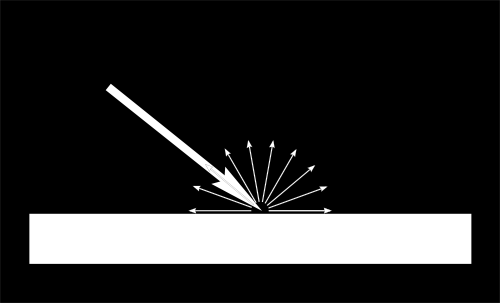
当一定量的光线到达某表面,该表面根据光到达时的角度而不同程度地被照亮。
如果光线垂直于表面,它将汇聚在一小片表面上。如果同等强度的光线以一个倾斜角到达表面,则其照亮的面积更大:
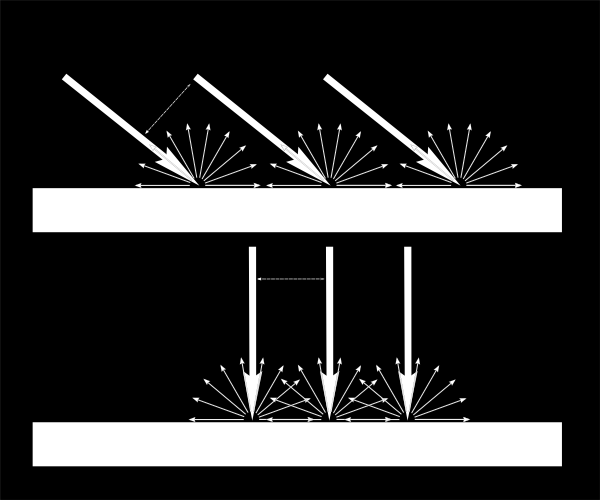
这意味着斜射下的表面各点会较暗(但请记住,更多的点会被照射到,总光强度仍然是一样的)
也就是说,当计算像素的颜色时,入射光和表面法线的夹角很重要。故有:
// Cosine of the angle between the normal and the light direction,// clamped above 0// - light is at the vertical of the triangle -> 1// - light is perpendicular to the triangle -> 0float cosTheta = dot( n,l );color = LightColor * cosTheta;
在这段代码中,n是表面法线,l是从表面到光源的单位向量(和光线方向相反。虽然不直观,但能简化数学计算)。
注意正负号
求cosTheta的公式有漏洞。如果光源在三角形后面,n和l方向相反,那么n.l是负值。这意味着colour将是一个负值,没有意义。因此这种情况下必须用clamp()将cosTheta截取为0:
// Cosine of the angle between the normal and the light direction,// clamped above 0// - light is at the vertical of the triangle -> 1// - light is perpendicular to the triangle -> 0// - light is behind the triangle -> 0float cosTheta = clamp( dot( n,l ), 0,1 );color = LightColor * cosTheta;
材质颜色
当然,输出颜色也受材质颜色的影响。在下图中,白光由绿、红、蓝光组成。当光碰到红色材质时,绿光和蓝光被吸收,只有红光得以保留。
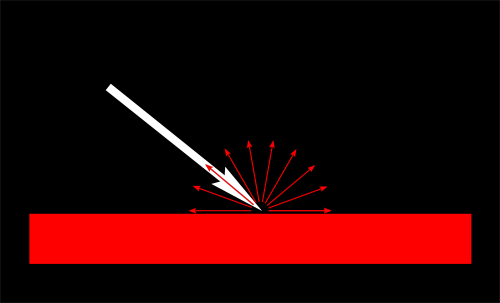
我们可以用一个简单的乘法来建模:
color = MaterialDiffuseColor * LightColor * cosTheta;
建立光照模型
首先假设在空间中有一个点光源,它像蜡烛一样向所有方向发射光线。
对于该光源,我们的表面收到的光通量(luminous flux)依赖于表面到光源的距离:越远光越少。实际上,光通量与距离的平方成反比:
color = MaterialDiffuseColor * LightColor * cosTheta / (distance*distance);
最后,需要另一个参数来控制光的强度。我们可以将其作为LightColor(随后的课程中会讲到)的变量,但是现在暂且只含一个颜色值(如白色)和一个强度(如60瓦)。
color = MaterialDiffuseColor * LightColor * LightPower * cosTheta / (distance*distance);
汇总
我们还需要一些参数(各种颜色和强度)和代码让程序运行起来。
可直接从纹理中获取MaterialDiffuseColor。
通过GLSL的uniform变量在着色器中设置LightColor和LightPower。
cosTheta由n和l决定。我们可以在任意空间中表示它们,最终结果都是一样的。这里选择摄像机空间,是因为在其中计算光源位置比较简单:
// Normal of the computed fragment, in camera spacevec3 n = normalize( Normal_cameraspace );// Direction of the light (from the fragment to the light)vec3 l = normalize( LightDirection_cameraspace );
在顶点着色器中计算Normal_cameraspace和LightDirection_cameraspace,然后传给片段着色器:
// Output position of the vertex, in clip space : MVP * positiongl_Position = MVP * vec4(vertexPosition_modelspace,1);// Position of the vertex, in worldspace : M * positionPosition_worldspace = (M * vec4(vertexPosition_modelspace,1)).xyz;// Vector that goes from the vertex to the camera, in camera space.// In camera space, the camera is at the origin (0,0,0).vec3 vertexPosition_cameraspace = ( V * M * vec4(vertexPosition_modelspace,1)).xyz;EyeDirection_cameraspace = vec3(0,0,0) - vertexPosition_cameraspace;// Vector that goes from the vertex to the light, in camera space. M is ommited because it's identity.vec3 LightPosition_cameraspace = ( V * vec4(LightPosition_worldspace,1)).xyz;LightDirection_cameraspace = LightPosition_cameraspace + EyeDirection_cameraspace;// Normal of the the vertex, in camera spaceNormal_cameraspace = ( V * M * vec4(vertexNormal_modelspace,0)).xyz; // Only correct if ModelMatrix does not scale the model ! Use its inverse transpose if not.
这段代码看起来很牛,其实就是第三课的所学内容:矩阵。每个向量命名时,都嵌入了所在的空间名,这样在跟踪时更简单。 这种做法值得借鉴。
M和V分别是模型和观察矩阵,并用与MVP完全相同的方式传给着色器。
实战时间
现在有了编写漫反射光源的一切必要条件。赶快动手把它实现出来吧。:)
结果
只有漫反射分量时,我们得到以下结果(呵呵,不好意思,纹理还是这么单调):
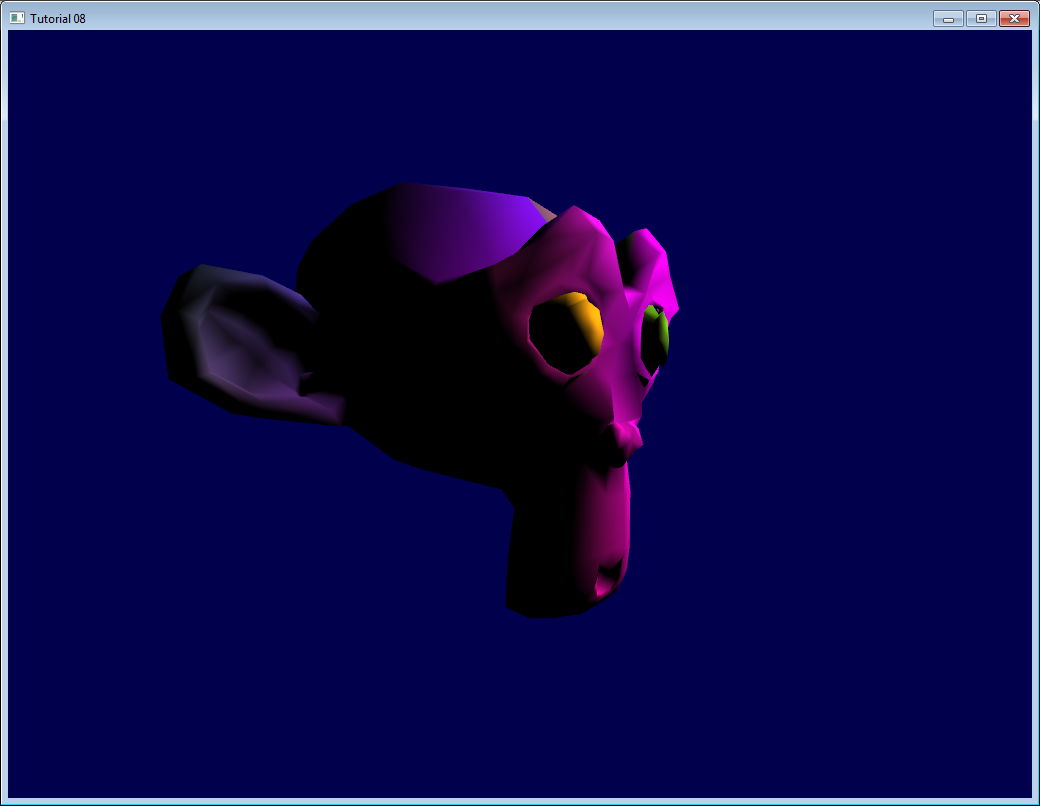
这次的结果比之前的好,不过还是感觉少了些什么。特别是由于使用了clamp(),Suzanne的背后完全是黑色的。
环境光(Ambient)分量
环境光分量是最具欺骗性的。
我们希望Suzanne的背后有一点亮光,因为在现实生活中灯泡会照亮它背后的墙,而墙会反过来(微弱地)照亮物体的背后。
但计算这种光照的代价大得可怕。
因此通常可以简单地以假的光源代替这种计算。实际中一般直接让三维模型发光,使它看起来不是漆黑一片就行了。
可这样操作:
vec3 MaterialAmbientColor = vec3(0.1,0.1,0.1) * MaterialDiffuseColor;color =// Ambient : simulates indirect lightingMaterialAmbientColor +// Diffuse : "color" of the objectMaterialDiffuseColor * LightColor * LightPower * cosTheta / (distance*distance) ;
来看看结果
结果
好的,效果变好些了。可以把(0.1,0.1,0.1)换成别的值来获得更好的效果。
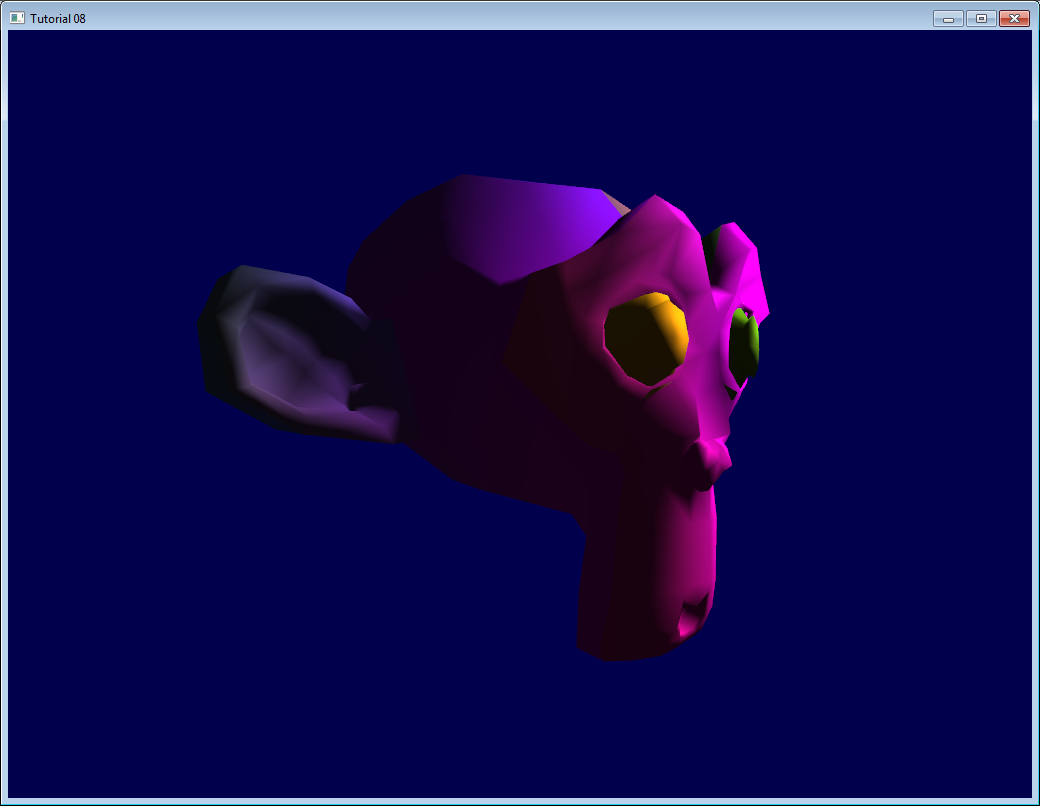
镜面光(Specular)分量
另一个反射光分量就是镜面光分量。这部分光在表面有确定的反射方向。
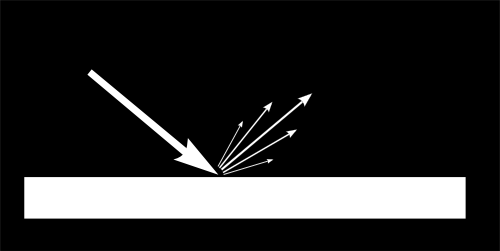
如图所示,镜面反射光形成了一个波瓣(lobe)。极端情况下,漫反射分量可为零,这时波瓣非常窄(所有的光往一个方向反射),这样就形成了镜子。
(确实可以通过调整参数值得到镜面;但在这个例子中镜面反射的只有光源,渲染结果看起来会很奇怪)
// Eye vector (towards the camera)vec3 E = normalize(EyeDirection_cameraspace);// Direction in which the triangle reflects the lightvec3 R = reflect(-l,n);// Cosine of the angle between the Eye vector and the Reflect vector,// clamped to 0// - Looking into the reflection > 1// - Looking elsewhere -> < 1float cosAlpha = clamp( dot( E,R ), 0,1 );color =// Ambient : simulates indirect lightingMaterialAmbientColor +// Diffuse : "color" of the objectMaterialDiffuseColor * LightColor * LightPower * cosTheta / (distance*distance) ;// Specular : reflective highlight, like a mirrorMaterialSpecularColor * LightColor * LightPower * pow(cosAlpha,5) / (distance*distance);
R是反射光的方向,E是视线的反方向(就像之前对“l”的假设);如果二者夹角很小,意味着视线与反射光线重合。
pow(cosAlpha,5)用来控制镜面反射的波瓣。可以通过增大第二个参数(译注:镜面高光指数)得到更大的波瓣。
最终结果
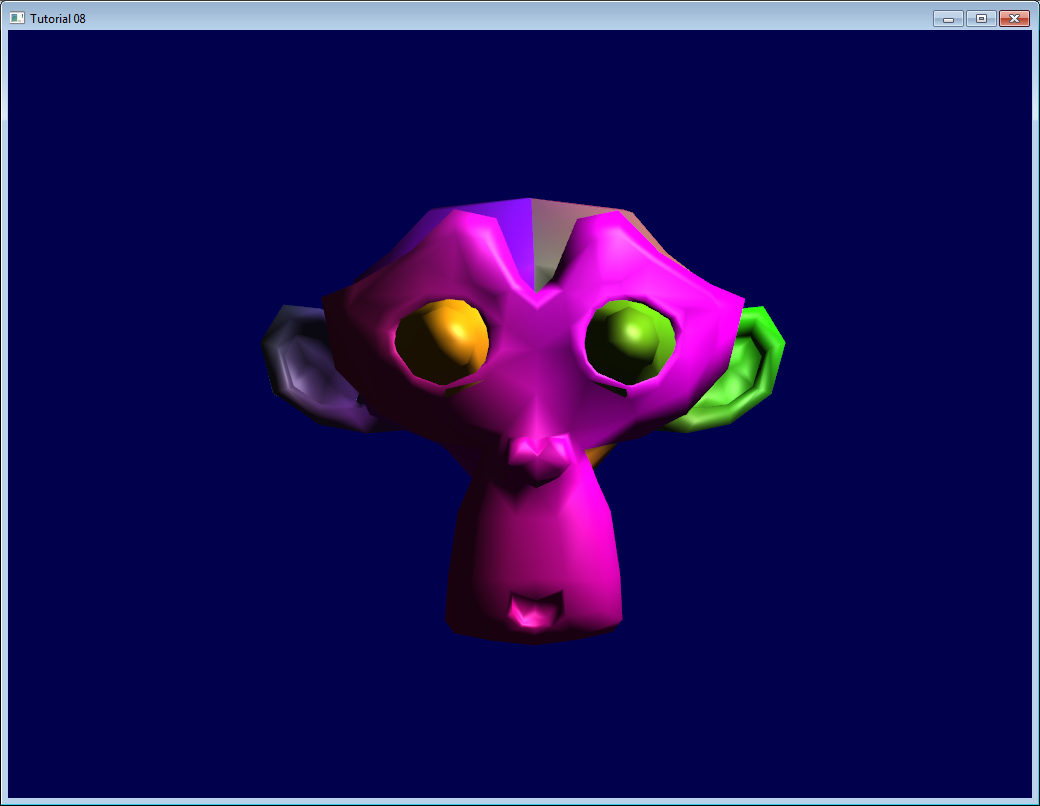
注意观察,由于有了镜面反射,鼻子和眉毛显得更亮了。
这个着色模型得益于其简单性,已经使用多年。但它存在很多问题,因而被microfacet BRDF(bidirectional reflection distribution function,微表面双向反射分布函数)之类的基于物理的(physically-based)模型所取代,这些内容后面会讲到。
下节课是第一节中级课程!我们将学习怎样提高VBO的性能。
© http://www.opengl-tutorial.org/
Written with Cmd Markdown.
